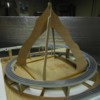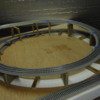Ah... the grandkids. They're coming back tomorrow from a trip to Europe with their parents and then leaving for 4 weeks of sleep-away camp this weekend. Then upon return they're headed to California to visit their other grandparents, and then school starts in mid-August around these parts, so I probably will have zero help from them. The oldest it turning 15 in a month and his interests are leaning elsewhere although he's still interested in what I'm doing. The younger one, primarily helped because his "older brother" was doing it, so I'm sure how much of his help is forthcoming. They have a ton of outside interests with music and tennis, plus social life that their days are completely filled. That's all okay. They're growing up great and the RR served its purpose. For me, it's still a blast so I ain't stopping.
For plastering, I use hardshell technique with gysolite-soaked paper towels over the cardboard frame. The dripping through is not a problem. A bigger problem is shaping the frame well enough so the "Cardboardness" of its nature isn't so obvious requiring too much Scupltamold to hide it. I just bought two more bags of it at Scale Reproductions which makes 3 on-hand, I'm probably going to need three times as much.
Ross shipped the track today so I'll be able to final form the sub roadbed. I'm holding off doing any more shaping until i have the track. I bought some more Spax star-head screws at THD today also. Lowe's, for some reason, doesn't carry this terrific product.
Also today, I got released from my hand doctor so that's on its way to be fully rectified. Any of you out there developing trigger finger problems, the surgery is not too awful. The incision heals in two weeks, the insides take about a month longer, and it takes about 6 months for it be fully normalized. The surgery hurts, but so did the trigger finger and it didn't work either. At least with the surgery out of way, I'm able to anything with that hand including getting my guitar chops back.






